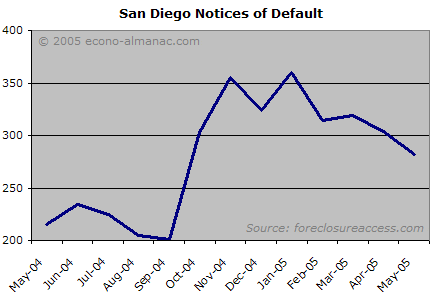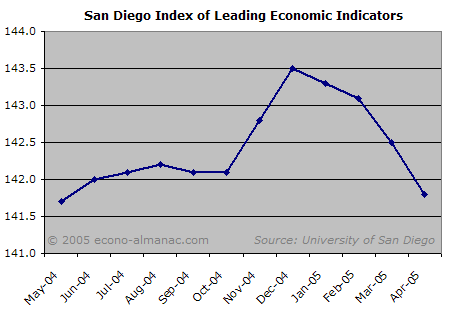As discussed in excruciating detail in the overview of Real Estate Market Indicators, I believe tracking mortgage default trends to be the best manner to measure the economic health of the San Diego homeowner population. And since housing pretty much is the San Diego economy, defaults are really one of the most important statistics overall.
The good, if unexciting, news is that at this point San Diego homeowners seem to be doing just fine. Defaults have continued to trend down steadily throughout 2005.

May 2005 defaults are up 31% over May 2004 defaults, but I think this simply reflects the fact the the San Diego homeowner has a slightly less ridiculous equity cushion to ease any economic pain. The household balance sheet is looking good for now, meaning that while inventory has grown a lot, it includes relatively few listings of the “must sell” variety.
On a less sanguine note, the University of San Diego’s Index of Leading Economic Indicators (LEI) has been trending down for several months now:

Dr. Alan Gin, the economist who maintains the LEI, interprets the data as follows:
Although a downturn in the local economy is unlikely in 2005, the outlook is for a weakening to occur in the second half of the year. Job growth will remain positive, but the local unemployment rate is likely to rise by the end of the year.
Now, I should mention here that I don’t actually know how valuable an indicator the LEI is. Our economy is so distorted by the real estate bubble that I have doubts about the effectiveness of traditional economic metrics. For example, the LEI interprets an increase in the number of building permits as a sign of future economic strength. This may be true in normal times, but during a record-breaking real estate bubble the increase in permits could just as well represent overbuilding by developers who are trying to cash in while prices are still sky-high. (Take a drive around Downtown if you don’t believe me).
But, while I still believe that mortgage defaults are the most relevant leading indicator as far as housing is concerned, there’s no harm in keeping tabs on the LEI to see if it offers anything interesting.
Conclusion
San Diego homes will not crash unless one or both of the following takes place:
- Credit tightens significantly, leading to higher rates and lending standards. This would hurt housing by rendering it impossible for many potential homebuyers to carry the cost of a home at current prices.
- A lot of local homeowners start running into serious economic trouble. In this situation we would likely see an increase of motivated home sellers and foreclosure sales.
Unless and until #1 or #2 occurs, prices may stagnate or trend down, but a crash is highly unlikely.
Right now San Diego unemployment is at 3.8%, and per the graph above San Diego homeowners are able to pay their bills. Notwithstanding the LEI, and the many longer-term risks I have outlined on these pages, it’s pretty clear that scenario #2 is nowhere in sight at this point.
Scenario #1, incidentally, warrants its own article, which will be forthcoming in a day or two. Suffice it to say that things are fairly rosy on that front as well, so it appears that San Diego housing is set to cruise along on autopilot for a while.
Incidentally, while I will be issuing monthly reports on the credit markets, the local economy, and the local housing market, I am constantly watching all three for signs of trouble, and I won’t wait to notify you if the red flags start flying.
